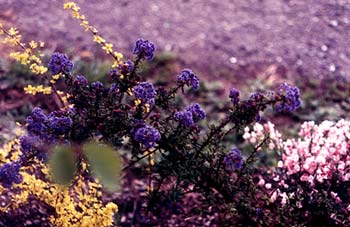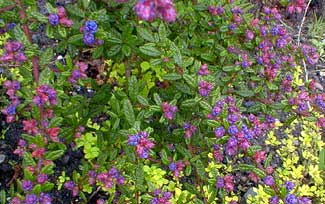 | |
| To the left of the blue-flowering Ceanothus is a dwarf Golden Japanese Barberry. To the right is Lilac Time False Heather. | |
Dwarf Santa Barbara Mountain Lilac;
or, California False Lilac
Most Cenaothus species bloom earlier in spring, but ours blooms April to July, & is at its height of blossom May & June, with minor reblooming through autumn. The specimen shown here out by the road was obtained inexpensively without a label about three years before this photo was taken in May 2002. In all that time it had grown only a little, seemingly healthy but staying small & leggy.
In the two years following, it finally put on some noticeable growth & became more compact (comparatively speaking) though not gaining but a couple of inches in height, mostly gaining in sideways growth. It also began in 2003 to bloom much more thrillingly than in earlier years.
The second photo is from April 2003, showing the shrub in full bud. The third photo is a couple weeks later in early May, showing the tendency to bloom in two color, the buds being purple & the flowers being a sharp bright blue.
 I've never been certain of the species but it doesn't look quite like the sundry Ceanothus griseus or the much larger C. impressus cultivars sold locally. C. griseus blooms sooner & spreads wider. The most common of several Ceanothus varieties seen locally is C. impressus, but varieties I've seen don't stay as small as ours, usually bloom later, & the leaves though small aren't as small as those on the one we have. So for a long time I thought ours had either to be a stunted cultivar of C. impressus or quite possibly the less commonly offered species-shrub C. dentatus. This latter's common name is Cutleaf Ceanothus or Cropleaf Ceanothus, occasionally called Dwarf Ceanothus because it is smallish, though there are much shorter species with wider spread. Our little specimen certainly behaves like C. dentatus, a small shrub with deepest blue flowers, & the species does usually bloom longer & later than most other species.
I've never been certain of the species but it doesn't look quite like the sundry Ceanothus griseus or the much larger C. impressus cultivars sold locally. C. griseus blooms sooner & spreads wider. The most common of several Ceanothus varieties seen locally is C. impressus, but varieties I've seen don't stay as small as ours, usually bloom later, & the leaves though small aren't as small as those on the one we have. So for a long time I thought ours had either to be a stunted cultivar of C. impressus or quite possibly the less commonly offered species-shrub C. dentatus. This latter's common name is Cutleaf Ceanothus or Cropleaf Ceanothus, occasionally called Dwarf Ceanothus because it is smallish, though there are much shorter species with wider spread. Our little specimen certainly behaves like C. dentatus, a small shrub with deepest blue flowers, & the species does usually bloom longer & later than most other species.I had previously asked on this page, "If you happen to recognize more certainly than I do which species or cultivar this is, do let me know, & I will revise this page." I eventually heard from landscaper Pam Sinclair, well-known in garden elist & newsgroups as Gardengal, who tells me: "Yours is undoubtedly a form of C. impressus, but most likely a hybrid. 'Dark Star' or 'Julia Phelps' are characterized by small, heavily textured foliage with a bit of a blue or gray cast, which has the effect ofİ tinting the electric blue flowers to a deeper violet color. If your plant still has not put on significant growth, it is possible it is a dwarf form of impressus called 'Vandenberg.'" With follow-up communication it seemed, if not 100% certain, at least extremely likely this is 'Vandenberg,' since it has grown so little in height. It still seems to me that ours blooms later & longer than is usually reported of any but C. dentatus, but for now I'm going with the advice that it is 'Vandenberg.'
 Most cultivars are somewhat fast-growing & can easily reach six or eight feet height & spread; but 'Vandenberg' has slower growth & takes a lot of years to exceed three feet height, growing wider than tall, to five foot width. It wants full sun & is very low maintenance & highly drought tolerant. It has tiny round evergreen leaves, as small as one-fourth inch. It is intolerant of wet soil & can be short-lived in soils that do not drain well.
Most cultivars are somewhat fast-growing & can easily reach six or eight feet height & spread; but 'Vandenberg' has slower growth & takes a lot of years to exceed three feet height, growing wider than tall, to five foot width. It wants full sun & is very low maintenance & highly drought tolerant. It has tiny round evergreen leaves, as small as one-fourth inch. It is intolerant of wet soil & can be short-lived in soils that do not drain well.This species has a strong preference for coastal gardens, being native to Santa Barbara & San Luis Obispo counties, California. It is vanishing from the wild because of housing developments & strip-malls. 'Vandenberg' is named for the air force base of that name, where the stunted shrubs were discovered in the 1980s, & first cultivated from salvaged specimens by M. Nevin Smith of Suncrest Nurseries, Inc.
Some ceanothus species including impressus are called by the unlovely name "Tick Bush" where they grow wild in California. Many sorts of shrubs get called Tick Bushes when they grow in hot dry areas where ticks use the higher arching branches as springboards to leap onto large mammals (including people).
Native peoples found the genus useful as a soap, because the flowers & seeds contain saponins that can be worked into a mild scented lather. Dyes were also made from the flowers.
The year I obtained this shrub was the year we bought the house, & I planted it as nearly the first thing in a corner of a yard where a garden did not yet exist but was quickly to take form. As the garden swiftly expanded, most of the new shrubs needed regular watering, & the Ceanothus was clearly suffering from the wet.
In nature, it would grow in areas where it would receive no summer rainfall at all, so I really had to get it out of the moist garden. I transplanted it at the very edge of a roadside garden at the head of the driveway, & avoided watering it, hoping the additional stress of transplant wouldn't cause it to further decline.
It was a little difficult to believe our normal rainfall was way more than sufficient for it, & that I wasn't supposed to water it ever. But I restrained myself, & it has done amazingly well ever since.
I would plant other no-maintenance Ceanothus species except they are alleged to be relatively short-lived plants that are well beyond their prime in a decade. They can actually live to be twenty or twenty-five years old, but only in areas where they never get too wet. There's some field study evidence that desert Ceanothus have fairly lengthy lifespans in the wild, but in the majority of gardening conditions the standard recommendation is to replace the shrubs every ten to fifteen years.